Picture-perfect shot soon after sunrise from our villa's deck:
A close-up shot of the ladder and the rope at the top to gain access to the bedroom loft!
Our property owner, Johnny's Polynesian mother was among the prettiest women I've ever seen. Would that I could look like her in another ten plus years! As Johnny and his mother needed to go into Uturoa, the biggest town on the island of Raiatea, we were able to get a lift, albeit a very cramped one, in the rear of their jeep so we could pick up a rental car for the next 24 hours. We were extremely fortunate to be able to get a car as often passengers from the mammoth cruise ships have reserved them all in advance.
After picking up the car, we stopped briefly to look at the Paroisse Catholique Saint Andre.
If you read and remembered my previous post about our brief stop in Pape'ete on Tahiti, you will recall the many murals I caught photos of. I was impressed with those we saw here on Raiatea even if we didn't know the stories behind the images.
The courtyard next to the large farmers' market was all decked out with Christmas regalia.
The bottom floor, like the Central Market in Pape'ete, was devoted to fruits and vegetables and the upper level to handicrafts.
I liked the wallet but didn't like it to the tune of $17. There were adorable dresses for our granddaughters but, at $45 apiece, they were more than I felt comfortable paying, especially not knowing if their parents would like them!
I loved the building's colorful roof and posts next to the waterfront which was entirely redeveloped with a new cruise terminal, and shops, restaurants, and a traditional handicrafts market.
There were other cute murals along the waterfront. Johnny's mother had told us they came about from a muralists' competition.
The ferry plying between Tahiti and Bora Bora stops here as does the frequent shuttle to the smaller Raiatea island of Taha'a.
About ten kilometers outside of town was Jardin Botanique de Faaroa. The strangest thing was, apart from the banner indicating its name, there was no office, and not a soul anywhere to pay admission to, or get information from so we just wandered along the well-manicured paths!
Birds of paradise:
Mango trees were introduced to Raiatea for their tasty orange fruit and its wood was used to make dugout canoes and for carpentry.
Only close up could we see the trees' pretty yellow flowers.
Polynesian chestnut tree:
We read that when ancient Polynesians landed in the Society Archipelago, they brought with them fewer than a hundred plants, three-quarters of which became naturalized, and thirty of those still present in this Faaroa Valley. Those plants were introduced for foods, cosmetics or dyes, medicines, construction and tools, and also ornaments.
Nahe was a giant fern, native from Malaysia to French Polynesia, that was cultivated for its ornamental leaves. The symbolic and legendary plant from Huahine used to be a subsistence food in times of scarcity.
If this is a similar photo to previous ones, I apologize but these birds of paradise flowers cast a spell on us they were so stunning!
Johnny, our villa owner, had told us to be on the lookout for the Promenade des Gabbros or Walk to the Gabbros just a few kms further. Raiatea's largest outcropping of the coarse-grained, dark-colored igneous gabbros was accessible via a short walk up a small hill. These weirdly shaped rocks were a geological curiosity that were rare in French Polynesia and marked the location of the volcano's main chimney that gave birth to the island of Raiatea.
The Faaroa Valley caldera forms a deep depression which was about 10 km by 6kms and bound by a ridgeline that culmintated at the island's highest point, 1,024m Mount Tefatua. The huge depression was the result of either the collapse or slip of a flank of the original volcano which caused these magmatic rocks to appear on the surface. I read that the Gabbro was formed during intense hydrothermal activity.
The rock was cut into vertical slabs by erosion and emerged from the red ferrous earth called 'mamu.'
Adjacent to the rocks was a plantation of Tamanu trees whose wood was used in cabinetmaking.
From atop the hill were magical views across the Toomaru mountain range.
A little further along the road was a superb view of Mount Tefatua at the heart of the crater. A number of crops were cultivated in the particularly fertile soil.
This was the first of many roadside stands we saw throughout the Polynesian islands selling local fruits and vegetables. Most of the stands were unmanned.
For close to ten kms, we saw identical plant upon plant along the road and wondered if they had been placed there by the roads department or locals to beautify the road.
Another example further along the road:
The hut in Opoa Bay looked very much like the pearl farm Steven and I had seen on Huahine a few days previously.
There was really nothing to see in the tiny village of Opoa except for the large Seventh-day Adventist Church. As I remarked previously, we'd never seen so many of their churches as we had so far just a week into our three-week visit to French Polynesia.
Another cute bathroom photo I would love to add to my collection but I dread the thought of going through thousands of posts going back to 2013 to find them all!
Thirty-two kms from Uturoa was Marae Taputapuatea, one of the largest and best-preserved temples in Polynesia and the island's most famous sight. Its mighty ahu or altar measured 43m long, over 7m wide, and 2-3m high. In front of the altar was a rectangular courtyard paved with black volcanic rock. A small platform in the middle of the ahu once bore the image of Oro, the god of fertility and war.
I wondered if the coral pieces had been placed on the rock just like stones placed on a gravesite in a Jewish cemetery in honor of a deceased loved one.
The ahu component of the marae descends from an ancient Polynesian practice of collecting a mound of dirt and erecting an upright stele in memory of a departed chief. The ahu, the most sacred part of the marae, was consecrated to gods and ancestors. Only certain priests could enter the marae during inauguration ceremonies. Over time ahus became increasingly more complex architecturally in the Windward and Leeward Islands.
Several of the temple platforms or ahus have been restored. Hauvivi was the welcoming marae where guests would have been received when they disembarked from their canoes. Rituals would then have been performed once they'd proceed to Marae Taputapuatea.
I learned that fires on the marae may once have been beacons to ancient navigators.
Departing chiefs would normally take a stone from this marae to be planted in new marae elsewhere which would then receive the name Marae Taputaputea.
About five thousand skulls were discovered during excavations at Papa Ofeoro, a place of sacrifice.
Beautiful shells had been placed all around the tree trunk but don't ask me why! Similar shells were available for sale in all the markets.
Near the beach was Opu Teina, the temple platform where visitors would say their goodbyes.
On a temple platform on the north side of the complex was Hiti Tai where meals were served. As there were few signs at the marae, we didn't know if this might have been the place.
The coral necklace looked like it had been placed lovingly or possibly reverently on the rock.
Liesbet and Sarah: I thought you'd both be interested to know that in 1995 a fleet of traditional Polynesian voyaging canoes, including three from Hawaii and two each from the Cook Islands and Tahiti, plus an Easter Island raft, gathered at Taputaputea to lift a 650-year-old curse and rededicate the marae. Navigating by the stars and swells, the seven canoes then left for the Marquesas Islands. Some continued onto Hawaii and the US west coast in an amazing demonstration of a revival of traditional culture.
We saw several piles of opened coconuts, I couldn't help but wonder if someone was trying to clean up the beach or why they were there.
Backrests still marked the seats of high chiefs in the courtyard.
The view of a motu or reef islet from the marae:
Bamboo trees:
As we continued our drive we spotted vanilla pods drying on the side of the road.
The Church of Jesus Christ of Latter-day Saints aka the Mormon church also had a strong presence in French Polynesia. I could hardly believe, based on the vast number of Seventh-day Adventist and Mormon churches we saw, that they comprised just five percent of the churches in the islands.
Another pearl farm possibly:
A pretty lookout point over the bay:
The remarkable rock formation was called Pain de Sucre de Fareatai.
Faatemu Bay:
Near Raiatea's southern tip was the tiny community of Pouhine that, if you blinked, you missed it.
Just as we'd been relieved to rent a car while on Huahine, having one here on Raiatea gave us the freedom to walk around the surprisingly empty botanical garden, discover the unusual gabbros rocks, explore the very important marae, and access the island's lovely coastal road. Thank goodness once again we weren't hungry or wanted a drink as there was literally not one place anywhere, except in Uturoa, to get anything!
How I wished I knew something of the gorgeous flowers we saw on the roadsides as these stretched for several kms.
A sight like this made one's dreams of French Polynesia come true!
Next post: Kayaking in Raiatea - really even though I thought we did that on the 7th of December and not the 8th!
Posted a month later on January 7th, 2022, from our home west of Denver. Even though the thermometer only said 50 today, it was so warm out only shirtsleeves were needed for my daily afternoon walk with a friend. You gotta love Denver's mild winters as long as they aren't accompanied by strong winds and fires.








































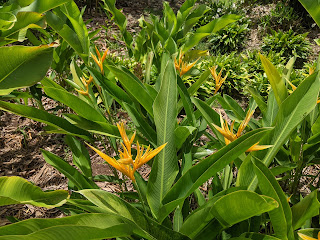







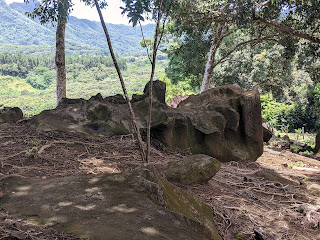








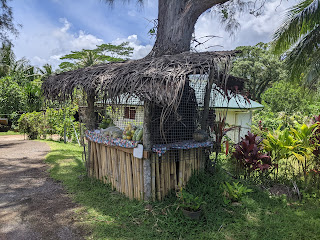





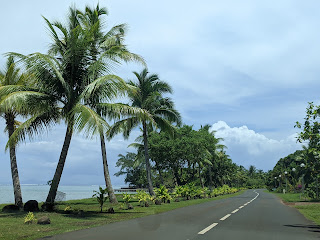


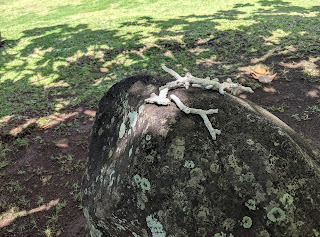





















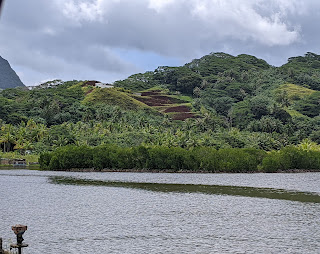



WoW ..gorgeous tropical flowers, gorgeous waterside vistas, inspiring temple platforms...Thanks for the tour. Lina in Tremblant.
ReplyDeleteWeren't the tropical flowers out of this world?! I couldn't stop snapping on pics as you might have guessed!
ReplyDelete